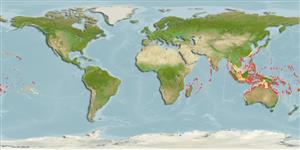Common names from other countries
Environment: milieu / climate zone / depth range / distribution range
Ökologie
seewasser riff-verbunden; tiefenbereich 0 - 36 m (Ref. 1602), usually 1 - 5 m (Ref. 90102). Tropical; 30°N - 32°S, 43°E - 130°W
Indo-Pacific: East Africa to the Hawaiian, Marquesan and Tuamoto islands, north to southern Japan and the Ogasawara Islands, south to New South Wales (Australia) and Lord Howe Island.
Size / Gewicht / Alter
Maturity: Lm ? range ? - ? cm
Max length : 13.0 cm TL Männchen/unbestimmt; (Ref. 9710)
Rückenflossenstacheln (insgesamt) : 13 - 14; Rückenflossenweichstrahlen (insgesamt) : 20 - 22; Afterflossenstacheln: 3; Afterflossenweichstrahlen: 16 - 17.
Common in shallow exposed reef flats, lagoons, and seaward reefs; in relatively open areas with scattered corals and occasionally at depth of 36 m (Ref. 205). Benthopelagic (Ref. 58302). May be solitary or in small groups (Ref. 90102). Usually in pairs. Juveniles often in small aggregations and commonly mix with other similar sized juveniles, especially C. kleinii. Feed on small worms, small benthic invertebrates, coral polyps, and filamentous algae. Oviparous. Form pairs during breeding (Ref. 205). Minimum depth reported taken from Ref. 128797.
Life cycle and mating behavior
Maturities | Fortpflanzung | Spawnings | Egg(s) | Fecundities | Larven
Distinct pairing (Ref. 205). Monogamous mating is observed as both obligate and social (Ref. 52884).
Myers, R.F., 1991. Micronesian reef fishes. Second Ed. Coral Graphics, Barrigada, Guam. 298 p. (Ref. 1602)
IUCN Rote Liste Status (Ref. 130435)
CITES (Ref. 128078)
Not Evaluated
Bedrohung für Menschen
Harmless
Nutzung durch Menschen
Fischereien: weniger kommerziell; Aquarium: Kommerziell
Tools
Zusatzinformationen
Download XML
Internet Quellen
Estimates based on models
Preferred temperature (Ref.
115969): 25 - 29.3, mean 28.3 (based on 2407 cells).
Phylogenetic diversity index (Ref.
82804): PD
50 = 0.5000 [Uniqueness, from 0.5 = low to 2.0 = high].
Bayesian length-weight: a=0.02344 (0.01499 - 0.03666), b=2.95 (2.82 - 3.08), in cm Total Length, based on LWR estimates for this species & Genus-body shape (Ref.
93245).
Trophic level (Ref.
69278): 3.5 ±0.3 se; based on diet studies.
Widerstandsfähigkeit (Ref.
120179): hoch, Verdopplung der Population dauert weniger als 15 Monate. (Preliminary K or Fecundity.).
Fishing Vulnerability (Ref.
59153): Low vulnerability (10 of 100).
